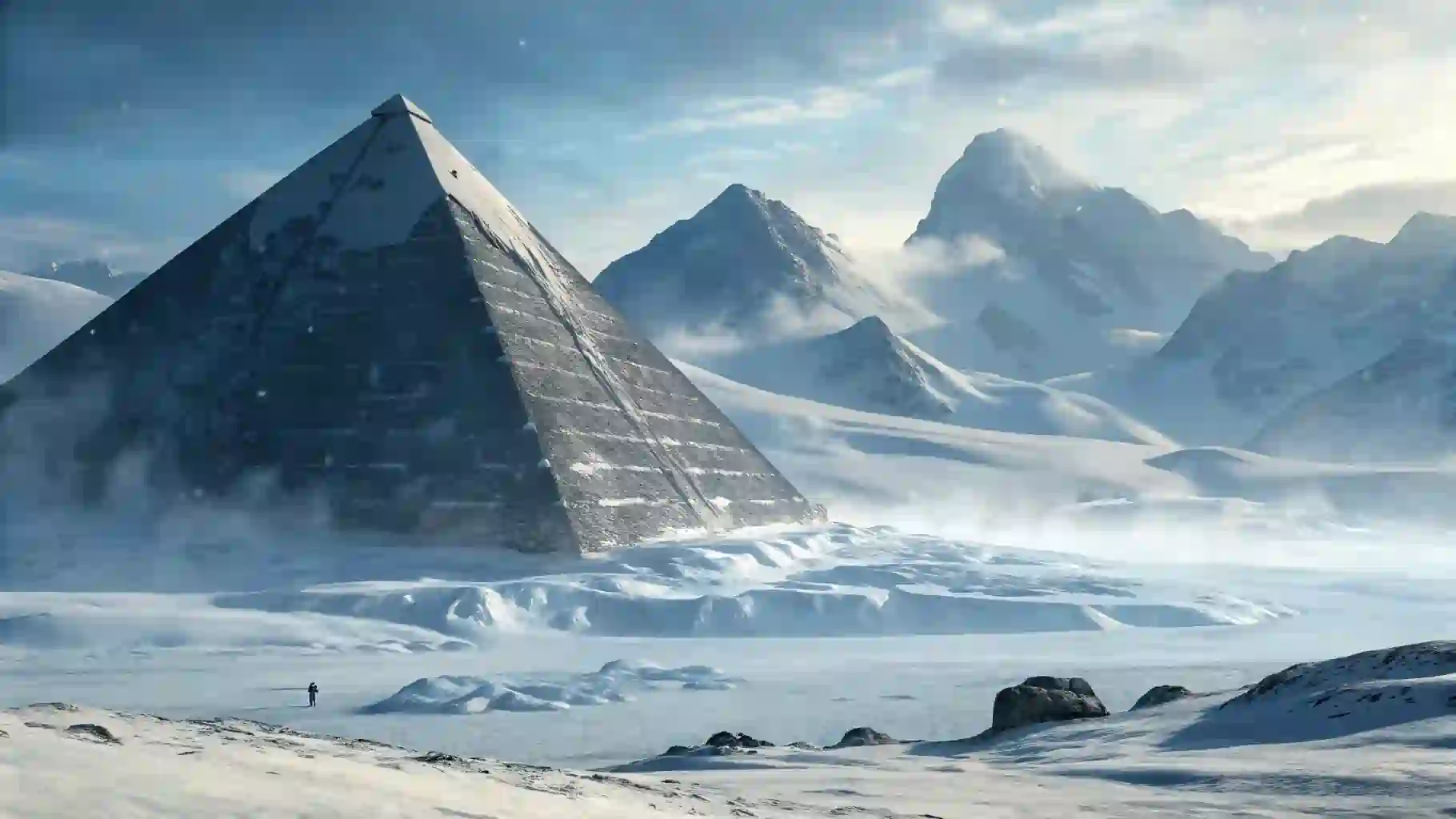Pyramid in Antarctica: A Natural Wonder Stirring Human Emotion

Introduction
In the heart of Antarctica’s frozen expanse, a formation rises that seems to defy nature’s randomness: the Pyramid in Antarctica. This striking, pyramid-shaped peak in the Ellsworth Mountains, with its sharp, symmetrical sides, looks like a relic from an ancient civilization. Since its viral spread in 2016, the pyramid antarctica has ignited emotions ranging from awe to intrigue, prompting wild theories about lost societies or extraterrestrial builders. For an emotion-driven perspective, this natural wonder is more than a geological oddity—it’s a symbol of humanity’s yearning for mystery and connection to the unknown. This guide delves into the science behind the Pyramid Antarctica, the emotions it evokes, and how it inspires us to explore both the world and our inner selves.
Unveiling the Pyramid in Antarctica
The Pyramid Antarctica is an unnamed mountain peak in the southern Ellsworth Mountains, part of the Heritage Range. Located at coordinates 79°58’39.25″S 81°57’32.21″W, this 4,150-foot (1,265-meter) peak captured global attention in 2016 when Google Earth imagery revealed its uncanny resemblance to the Great Pyramid of Giza.
First documented during a 1935 flight by American aviator Lincoln Ellsworth, the peak is a nunatak—a rocky summit protruding through ice—shaped by millions of years of natural processes. Its four steep, symmetrical sides and 2-kilometer-square base make it a visual marvel, stirring emotions that bridge the familiar and the unknown.
Image/Infographic Suggestion: Include a satellite image of the pyramid-shaped peak alongside a silhouette of the Great Pyramid of Giza to highlight their striking similarity.
The Geological Story
Geologists like Eric Rignot from the University of California, Irvine, attribute the pyramid’s shape to freeze-thaw erosion. Water seeps into rock cracks during brief thaws, freezes at night, and expands, breaking off rock fragments over millions of years. Combined with glacial convergence, this process sculpts sharp, angular features in the uniform sedimentary rocks of the Ellsworth Mountains, formed 150 million years ago. Similar peaks, like the Matterhorn in Switzerland or Alpamayo in Peru, showcase nature’s ability to create pyramid-like forms, proving that no human or alien hands were needed.
The Illusion of Design
The pyramid’s man-made appearance is a result of pareidolia, a psychological phenomenon where we see familiar patterns—like pyramids—in natural forms. This illusion is emotionally powerful, evoking wonder and curiosity as we project human-like intent onto nature’s work. The pyramid antarctica feels like a discovery that could rewrite history, fueling our imagination and emotional connection to the unknown.
Image/Infographic Suggestion: Create a diagram illustrating freeze-thaw erosion, showing water freezing in rock cracks and shaping the pyramid over time.
The Emotional Pull of the Pyramid in Antarctica
The Pyramid Antarctica resonates deeply because of its setting in Antarctica’s alien landscape and its ability to stir profound emotions.
Awe at Nature’s Artistry
The pyramid’s perfect symmetry against a backdrop of endless ice evokes awe. Its resemblance to human-made pyramids, like those in Egypt, taps into our fascination with ancient achievements, making the peak feel like a cosmic gift. Social media posts on X describe it as “stunning” or “unreal,” reflecting a shared sense of wonder at nature’s ability to mimic human design. This awe connects us to the sublime beauty of Earth’s remotest corners.
Curiosity and the Quest for Meaning
The pyramid antarctica sparks curiosity, driving speculation about its origins. X posts suggest it could be a “pre-flood civilization” or an “alien artifact,” showing how the pyramid fuels imaginative narratives. While geologists debunk these theories, the emotional need to explore “what if” scenarios keeps the mystery alive, reflecting our desire to uncover hidden truths.post:2,4
Fear of the Unexplored
Antarctica’s extreme climate—averaging -30°C—and vast isolation evoke a primal fear of the unknown. The pyramid, rising from the ice, feels like a secret uncovered, stirring unease about what else lies hidden. Pop culture, like the 1998 X-Files movie, amplifies this fear by portraying Antarctica as a hub for extraterrestrial mysteries, tapping into our collective anxiety about the unknown.
Image/Infographic Suggestion: Include a mood board with images of the pyramid, Antarctic ice, and ancient pyramids to evoke the emotional contrast between mystery and science.
Debunking Myths with Emotional Insight
The Pyramid Antarctica has inspired numerous conspiracy theories, each reflecting our emotional need to explain the unexplainable.
Common Conspiracy Theories
- Ancient Civilizations: Some claim Antarctica was once warm, hosting pyramid-building societies. Geological evidence shows it has been ice-covered for millions of years, ruling out human habitation.web:4,14
- Extraterrestrial Origins: Theories of alien construction surged after 2016, fueled by shows like Ancient Aliens. Experts like Mitch Darcy clarify that the pyramid is a natural nunatak, not an alien structure.web:13,22
- Piri Reis Map: This 16th-century map is cited as evidence of an ice-free Antarctica, but it depicts known coastlines, not lost civilizations.
The Scientific Reality
Geologists describe the pyramid as a glacial horn, formed by converging glaciers and freeze-thaw erosion. Its uniform rock composition creates a rare four-sided shape, similar to peaks like Mount Búlandstindur in Iceland. The pyramid’s “discovery” in 2016 was not new—it was documented decades earlier, with its fame driven by accessible satellite imagery.web:15,22
Image/Infographic Suggestion: Create a comparison chart showing the Antarctic pyramid alongside other glacial horns (e.g., Matterhorn, Mount Búlandstindur) to illustrate their natural origins.
Pareidolia: The Emotional Bridge
Pareidolia, the tendency to see familiar patterns in random forms, is key to the pyramid antarctica’s allure. Psychologically, it connects the familiar (human-made pyramids) with the alien (Antarctica’s wilderness), creating an emotional spark. This phenomenon fuels our fascination, as we project hopes, fears, and curiosities onto the peak. For example, seeing a pyramid in a mountain evokes a sense of connection to ancient cultures, even when no such link exists.
Why We Crave Mysteries
Mysteries like the Pyramid in Antarctica resonate because they challenge our understanding and ignite imagination. They evoke:
- Hope: The possibility of a lost civilization offers hope for uncovering hidden truths.
- Excitement: The idea of rewriting history excites our sense of adventure.
- Connection: Sharing theories online, as seen in X posts with thousands of interactions, fosters community.post:0,3
Antarctica’s Emotional Tapestry
The Pyramid in Antarctica is one of many phenomena that make Antarctica an emotional touchstone.
Other Antarctic Wonders
- Blood Falls: Iron-rich water seeping from a subglacial lake creates a striking red flow, evoking awe and curiosity.
- Subglacial Lakes: Lakes like Vostok, buried miles beneath ice, spark wonder about hidden ecosystems.
- Fossils: The Ellsworth Mountains hold 500-million-year-old Cambrian fossils, connecting us to Earth’s ancient past.web:7,9
Why Antarctica Captivates
Antarctica’s extremes—freezing temperatures, vast ice sheets, and isolation—amplify its emotional impact. It represents the unknown, a final frontier where nature’s power reigns. The pyramid, as a symbol of this enigma, stirs our desire to explore and connect with the planet’s mysteries.
Image/Infographic Suggestion: Include a map of Antarctica highlighting the Ellsworth Mountains, Blood Falls, and Lake Vostok to contextualize the pyramid’s location.
Eco-Emotions and the Pyramid
The Pyramid in Antarctica also evokes eco-emotions—feelings tied to environmental change. As climate change melts Antarctic ice, revealing features like the pyramid, it triggers eco-anxiety, ecological grief, or empowerment to act. The pyramid’s visibility, heightened by ice retreat, reminds us of Earth’s fragility, blending awe with urgency to protect it.
Image/Infographic Suggestion: Create a graph showing Antarctic ice loss over decades, with a marker for 2016 when the pyramid gained fame, to link climate change and emotional impact.
Experiencing the Pyramid’s Emotional Power
Engaging with the pyramid antarctica offers emotional and intellectual rewards.
Virtual Exploration
- Google Earth: View the pyramid at 79°58’39.25″S 81°57’32.21″W to experience its scale and isolation.
- Online Communities: Join forums like Reddit’s r/AlternativeHistory to share emotions and theories.
Physical Expeditions
- When to Go: Antarctic summer (November-January) offers milder conditions and 24-hour daylight.
- How to Visit: Cruises to the Antarctic Peninsula or expeditions to the Ellsworth Mountains, like those near Patriot Hills, provide access.
- Emotional Impact: Expect humility from Antarctica’s vastness, inspiration from its beauty, and reflection from its solitude.
Image/Infographic Suggestion: Include a photo collage of Antarctic expedition scenes, showing cruise ships, ice landscapes, and researchers at Patriot Hills.
Practical Tips for Emotional Engagement
To connect with the Pyramid in Antarctica’s emotional resonance:
- Practice Mindfulness: Meditate on the pyramid’s mystery to cultivate awe and gratitude.
- Learn Geology: Understanding glacial erosion deepens appreciation for nature’s artistry.
- Support Conservation: Advocate for Antarctic preservation to channel eco-emotions into action.
- Create Art: Draw or write about the pyramid to process feelings of wonder or unease.
- Share Stories: Discuss the pyramid online to build community around its mystery.
Frequently Asked Questions (FAQs)
- Is the Pyramid in Antarctica man-made?
- No, it’s a natural glacial horn shaped by freeze-thaw erosion, not a human or alien structure.
- Why does the pyramid look so perfect?
- Uniform rock composition and glacial convergence create its rare four-sided shape, similar to peaks like the Matterhorn.
- Could ancient civilizations have lived in Antarctica?
- No, Antarctica’s ice-covered climate for millions of years makes human habitation impossible.
- Are there other pyramids in Antarctica?
- Yes, peaks like “The Pyramid” near Koettlitz Glacier share similar shapes due to glacial erosion.
- How can I see the Pyramid in Antarctica?
- View it via Google Earth or join an Antarctic expedition during November-January.
- Why does the pyramid evoke such strong emotions?
- Its man-made appearance, driven by pareidolia, taps into awe, curiosity, and fear of the unknown.
Conclusion
The Pyramid in Antarctica is a natural masterpiece that transcends its geological roots, becoming a powerful symbol of human emotion. Shaped by millions of years of glacial erosion in the Ellsworth Mountains, this pyramid antarctica evokes awe, curiosity, and a touch of fear, reflecting our fascination with the unknown. By blending scientific understanding with emotional exploration, we connect with Antarctica’s untouched beauty and our own capacity for wonder. Whether through virtual tours or future expeditions, the Pyramid Antarctica invites us to embrace the mysteries that stir our hearts and inspire our souls.
Explore More On This Topic: Digital Media and Emotional Intelligence: A Growing Connection






